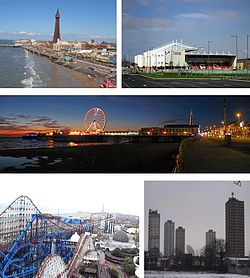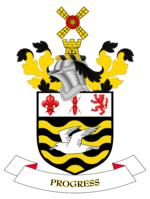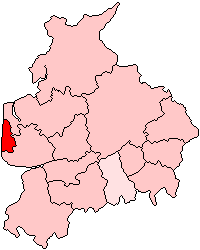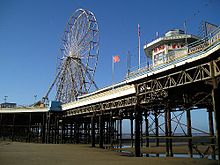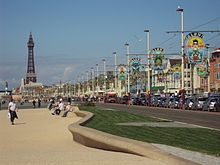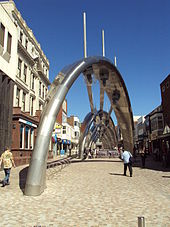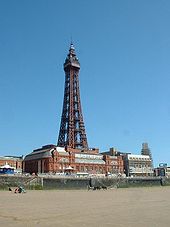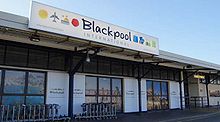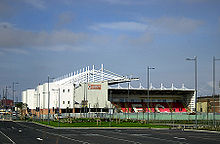
Blackpool
About this schools Wikipedia selection
SOS Children offer a complete download of this selection for schools for use on schools intranets. A quick link for child sponsorship is http://www.sponsor-a-child.org.uk/
| Blackpool | ||
|---|---|---|
| — Town, Unitary Authority & Borough — | ||
|
||
| Shown within ceremonial Lancashire | ||
| Coordinates: 53°48′51″N 03°03′01″W | ||
| Sovereign state | United Kingdom | |
| Constituent country | England | |
| Region | North West England | |
| Ceremonial county | Lancashire | |
| Founded | ||
| Admin. HQ | Blackpool | |
| Government | ||
| • Type | Blackpool Borough Council | |
| • Leadership: | Leader & Cabinet | |
| • Executive: | Labour | |
| • MPs: | Paul Maynard (C) Gordon Marsden (L) |
|
| Area | ||
| • Total | 13.46 sq mi (34.85 km2) | |
| Area rank | 302nd | |
| Elevation | 16 ft (5 m) | |
| Population (2011 est.) | ||
| • Total | 142,100 | |
| • Rank | Ranked 135th | |
| • Density | 11,000/sq mi (4,100/km2) | |
| Time zone | Greenwich Mean Time ( UTC+0) | |
| • Summer ( DST) | British Summer Time ( UTC+1) | |
| Postcode | FY1-FY4 | |
| Area code(s) | 1253 | |
| ISO 3166-2 | ||
| ONS code | 00EY (ONS) E06000009 (GSS) |
|
| OS grid reference | ||
| NUTS 3 | ||
| Ethnicity | 95.5% White 2.0% South Asian 0.9% Mixed 0.8% Black 0.6% Chinese 0.2% Other Asian Estimate |
|
| Website | visitblackpool.com blackpool.gov.uk |
|
Blackpool / ˈ b l æ k p uː l / is a borough, seaside town, and unitary authority area of Lancashire, in North West England. It is situated along England's northwest coast by the Irish Sea, between the Ribble and Wyre estuaries, 17.5 miles (28.2 km) northwest of Preston, 27 miles (43 km) north of Liverpool, 30 miles (48 km) northwest of Bolton and 40 miles (64 km) northwest of Manchester. It has an estimated population of 142,100, and a population density that makes it the fourth most densely populated borough of England and Wales outside Greater London.
Throughout the Middle Ages and Early Modern period, Blackpool was a coastal hamlet in Lancashire's Hundred of Amounderness, and remained such until the mid-18th century when it became fashionable in England to travel to the coast during the summer to bathe in sea water to improve well-being. In 1781, visitors attracted to Blackpool's 7-mile (11 km) sandy beach were able to use a newly built private road, built by Thomas Clifton and Sir Henry Hoghton. Stagecoaches began running to Blackpool from Manchester in the same year, and from Halifax in 1782. In the early 19th century, Henry Banks and his son-in-law John Cocker erected new buildings in Blackpool such that its population grew from less than 500 in 1801 to over 2,500 in 1851. St John's Church in Blackpool was consecrated in 1821.
Blackpool rose to prominence as a major centre of tourism in England when a railway was built in the 1840s connecting it to the industrialised regions of Northern England. The railway made it much easier and cheaper for visitors to reach Blackpool, triggering an influx of settlers, such that in 1876 Blackpool was incorporated as a borough, governed by its own town council and aldermen. In 1881 Blackpool was a booming resort with a population of 14,000 and a promenade complete with piers, fortune-tellers, public houses, trams, donkey rides, fish-and-chip shops and theatres. By 1901 the population of Blackpool was 47,000, by which time its place was cemented as "the archetypal British seaside resort". By 1951 it had grown to 147,000.
Shifts in tastes, combined with opportunities for Britons to travel overseas, supplanted Blackpool's status as a leading resort during the late 20th century. Nevertheless, Blackpool's urban fabric and economy remains relatively undiversified, and firmly rooted in the tourism sector, and the borough's seafront continues to attract millions of visitors every year. In addition to its sandy beaches, Blackpool's major attractions and landmarks include Blackpool Tower, Blackpool Illuminations, the Pleasure Beach, Blackpool Zoo, the Winter Gardens, and the UK's only surviving first-generation tramway. Blackpool is also noted for its political autonomy, independent of Lancashire County Council.
History
Toponymy
Blackpool gets its name from a historic drainage channel (possibly Spen Dyke) that ran over a peat bog, discharging discoloured water into the Irish Sea, which formed a black pool (on the other side of the sea, "Dublin" (Dubh Linn) is derived from the Irish for "black pool"). Another explanation is that the local dialect for stream was "pul" or "poole", hence "Black poole".
People originating from Blackpool are called Sandgrown'uns (as are persons originating from Morecambe and Southport) or Seasiders (although this is more commonly associated with Blackpool F.C.). Blackpudlians is also (though rarely) used.
Early history
A 12,000-year-old animal skeleton (the Carleton Elk) found with barbed arrowheads near Blackpool Sixth Form College in 1970 provided the first evidence of humans living on the Fylde as far back as the Palaeolithic era. The Fylde was also home to a British tribe, the Setantii (the "dwellers in the water") a sub-tribe of the Brigantes, who from about AD80 were controlled by Romans from their fort at Dowbridge, Kirkham. During the Roman occupation the area was covered by oak forests and bog land.
Some of the earliest villages on the Fylde, which were later to become part of Blackpool town, were named in the Domesday Book in 1086. Many of them were Anglo-Saxon settlements. Some though had 9th and 10th century Viking place names. The Vikings and Anglo-Saxons seem to have co-existed peacefully, with some Anglo-Saxon and Viking placenames later being joined together – such as Layton-with-Warbreck and Bispham-with-Norbreck. Layton was controlled by the Butlers, Barons of Warrington from the 12th century.
In medieval times Blackpool emerged as a few farmsteads on the coast within Layton-with-Warbreck, the name coming from "le pull", a stream that drained Marton Mere and Marton Moss into the sea close to what is now Manchester Square. The stream ran through peatlands that discoloured the water, so the name for the area became "Black Poole". In the 15th century the area was just called Pul, and a 1532 map calls the area "the pole howsys alias the north howsys”.
In 1602, entries in Bispham Parish Church baptismal register include both Poole and for the first time blackpoole. The first house of any substance, Foxhall, was built toward the end of the 17th century by Edward Tyldesley, the Squire of Myerscough and son of the Royalist Sir Thomas Tyldesley. An Act of Parliament in 1767 enclosed a common, mostly sand hills on the coast, that stretched from Spen Dyke southwards. Plots of the land were allocated to landowners in Bispham, Layton, Great Marton and Little Marton. The same act also provided for the layout of a number of long straight roads that would be built, such as Lytham Road, St. Annes Road and Highfield Road.
Taking the cure
By the middle of the 18th century, the practice of sea bathing to cure diseases was becoming fashionable among the wealthier classes, and visitors began making the arduous trek to Blackpool for that purpose. In 1781 Thomas Clifton and Sir Henry Hoghton built a private road to Blackpool, and a regular stagecoach service from Manchester and Halifax was established. A few amenities, including four hotels, an archery stall and bowling greens, were developed, and the town grew slowly. The 1801 census records the town's population at 473. The growth was accelerated by the actions of Henry Banks, often considered to be the “Father of Blackpool”. In 1819 he purchased the Lane Ends estate, including the Lane Ends Hotel, and built the first holiday cottages. In 1837, his son-in-law Dr. John Cocker built Blackpool’s first assembly rooms, which still stand on the corner of Victoria Street and Bank Hey Street.
Arrival of the railways
The most significant event in the early growth of the town occurred in 1846, with the completion of a branch line to Blackpool from Poulton on the main Preston and Wyre Joint Railway line from Preston to Fleetwood. Fleetwood declined as a resort, as its founder and principal financial backer, Peter Hesketh-Fleetwood, went bankrupt. In contrast, Blackpool boomed. A sudden influx of visitors, arriving by rail, provided the motivation for entrepreneurs to build accommodation and create new attractions, leading to more visitors and a rapid cycle of growth throughout the 1850s and 1860s. In 1851 a Board of Health was formed. Gas lighting was introduced in 1852, and piped water in 1864. By 1851, the town's population was over 2,500.
The growth was intensified by the practice among the Lancashire cotton mill owners of closing the factories for a week every year to service and repair machinery. These became known as wakes weeks. Each town's mills would close for a different week, allowing Blackpool to manage a steady and reliable stream of visitors over a prolonged period in the summer.
In 1863, the North Pier was completed, rapidly becoming a centre of attraction for elite visitors. Central Pier was completed in 1868, with a theatre and a large open-air dance floor. The town expanded southward beyond what is today known as the Golden Mile, towards South Shore, and South Pier was completed in 1893, making Blackpool the only town in the United Kingdom with three piers. In 1878, the Winter Gardens complex opened, incorporating ten years later the Opera House, said to be the largest in Britain outside of London.
The town was granted a Charter of Incorporation as a municipal borough in 1876. W.H. Cocker, son of Dr John Cocker, and therefore grandson of Henry Banks, was its first mayor. The town would become a county borough in 1904.
Electricity
Much of Blackpool's growth and character from the 1870s on was predicated on the town's pioneering use of electrical power. In 1879, it became the first municipality in the world to have electric street lighting, as large parts of the promenade were wired. The lighting and its accompanying pageants reinforced Blackpool's status as the North of England's most prominent holiday resort, and its specifically working class character. It was the forerunner of the present-day Blackpool Illuminations. In 1885 one of the world's first electric tramways was laid down as a conduit line running from Cocker Street to Dean Street on the Promenade. The line was operated by the Blackpool Electric Tramway Company until 1892 when their lease expired and Blackpool Corporation took over running the line. A further line was added in 1895 from Manchester Square along Lytham Road to South Shore, and the line was extended north, first to Gynn Square in 1899, and then to Fleetwood. In 1899 the conduit system was replaced by overhead wires. The tramway has remained in continuous service to this day.
By the 1890s, the town had a population of 35,000, and could accommodate 250,000 holidaymakers. The number of annual visitors, many staying for a week, was estimated at three million. 1894 saw the opening of two of the town's most prominent buildings, the Grand Theatre on Church Street, and Blackpool Tower on the Promenade. The Grand Theatre was one of Britain's first all-electric theatres.
The first decade of the new century saw the development of the Promenade as we know it today, and further development southwards beyond South Shore towards Harrowside and Squires Gate. The Pleasure Beach was first established about this time. Seasonal static illuminations were first set up in 1912, although due to World War I and its aftermath they only enjoyed two seasons until they were re-introduced in 1925. The illuminations extended the holiday season into September and early October.
Towards the present
The inter-war period saw Blackpool attain pre-eminence as a holiday destination. By 1920, Blackpool claimed around eight million visitors per year, three times as many as its nearest British rivals, still drawn largely from the mill towns of East Lancashire and the West Riding of Yorkshire. Stanley Park was laid out in 1920 and opened in 1926. The area round the park has become renowned for some of the most desirable residences in the area.
In 1937, Littlewoods opened its first department store in the town.
Documents have been found to suggest that the reason Blackpool escaped heavy damage in World War II was that Adolf Hitler had earmarked the town to remain a place of leisure after his planned invasion. Despite this, on 11 September 1940, German bombs fell near Blackpool North railway station and eight people were killed in nearby houses.
In the same war, the Free Polish Air Force made its headquarters in exile at Blackpool in Talbot Square, after the force evacuated to Britain from France. The nearby Layton Cemetery contains the war graves of 26 Polish airmen.
Blackpool's population boom was complete by 1951, by which time some 147,000 people were living in the town—compared to 47,000 in 1901 and a mere 14,000 in 1881. In the decade after the war, the town continued to attract more visitors, reaching a zenith of 17 million per year. However, several factors combined to make this growth untenable. The decline of the textile industry led to a de-emphasis of the traditional week-long break. The rise of package holidays took many of Blackpool's traditional visitors abroad, where the weather was more reliably warm and dry, and improved road communications, epitomised by the construction of the M55 motorway in 1975, made Blackpool more feasible as a day trip rather than an overnight stay. The economy, however, remains relatively undiversified, and firmly rooted in the tourism sector.
Local government
Though the Blackpool Urban Area extends beyond the statutory boundaries of Blackpool to encompass Fleetwood, Cleveleys, Thornton, Poulton-le-Fylde and Lytham St Annes, Blackpool remains administratively separate.
Between 1904 and 1974, Blackpool formed a county borough independent of the administrative county of Lancashire. With the passage of the Local Government Act 1972, Blackpool's county borough status was abolished and it was made part of the shire county of Lancashire. On 1 April 1998, however, Blackpool was made a unitary authority and re-formed as an autonomous local government unit. It remains part of Lancashire for ceremonial purposes, however.
As of the 2011 election Blackpool Council is currently controlled by the Labour Party, having taken control from the Conservatives. They are the largest party represented with 27 councillors (gained 15) and a governmental majority of 12, followed by the Conservative Party with 14 councillors (loss of 13) and the Liberal Democrats with 1 (loss of 2).
| Year | Labour | Conservatives | Liberal Democrats |
|---|---|---|---|
| 2011 | 27 | 14 | 1 |
Climate
Blackpool has, like all of the UK, a temperate maritime climate according to the Köppen climate classification system, translating to a limited annual temperature range, rainfall throughout the year, and high wind levels.
The absolute maximum temperature recorded at Blackpool was 33.7 °C (92.7 °F) during July 1976. The highest temperature to occur in recent years is 33.2 °C (91.8 °F) during July 2006. In a more normal summer, the warmest day will likely average 28.1 °C (82.6 °F), with slightly fewer than 5 days a year attaining a temperature of 25.1 °C (77.2 °F) or above.
The absolute minimum temperature stands at −15.1 °C (4.8 °F), recorded during December 1981. The lowest temperature to occur in recent years is −11.9 °C (10.6 °F) during December 2010. In a more normal winter, the coldest night averages −7.6 °C (18.3 °F).
Rainfall averages slightly less than 900 mm (35 in), with over 1 mm of precipitation occurring on 143 days of the year.
| Climate data for Blackpool 10m asl, 1971–2000, extremes 1960– | |||||||||||||
|---|---|---|---|---|---|---|---|---|---|---|---|---|---|
| Month | Jan | Feb | Mar | Apr | May | Jun | Jul | Aug | Sep | Oct | Nov | Dec | Year |
| Record high °C (°F) | 14.3 (57.7) |
15.6 (60.1) |
19.1 (66.4) |
24.0 (75.2) |
26.8 (80.2) |
31.3 (88.3) |
33.7 (92.7) |
32.2 (90) |
26.8 (80.2) |
23.7 (74.7) |
16.8 (62.2) |
14.2 (57.6) |
33.7 (92.7) |
| Average high °C (°F) | 6.8 (44.2) |
7.1 (44.8) |
9.1 (48.4) |
11.6 (52.9) |
15.2 (59.4) |
17.3 (63.1) |
19.4 (66.9) |
19.4 (66.9) |
17.0 (62.6) |
13.7 (56.7) |
9.8 (49.6) |
7.6 (45.7) |
12.9 (55.2) |
| Average low °C (°F) | 1.7 (35.1) |
1.6 (34.9) |
3.1 (37.6) |
4.2 (39.6) |
6.9 (44.4) |
10.0 (50) |
12.4 (54.3) |
12.3 (54.1) |
10.2 (50.4) |
7.3 (45.1) |
4.3 (39.7) |
2.5 (36.5) |
6.4 (43.5) |
| Record low °C (°F) | −11.3 (11.7) |
−13.2 (8.2) |
−9.7 (14.5) |
−6.1 (21) |
−1.9 (28.6) |
−1.0 (30.2) |
3.3 (37.9) |
1.9 (35.4) |
−0.7 (30.7) |
−4.3 (24.3) |
−7.0 (19.4) |
−15.1 (4.8) |
−15.1 (4.8) |
| Precipitation mm (inches) | 81.1 (3.193) |
58.7 (2.311) |
68.3 (2.689) |
48.9 (1.925) |
49.0 (1.929) |
59.8 (2.354) |
59.5 (2.343) |
73.4 (2.89) |
82.5 (3.248) |
97.9 (3.854) |
94.0 (3.701) |
98.3 (3.87) |
871.4 (34.307) |
| Mean monthly sunshine hours | 52.4 | 70.9 | 106.3 | 160.8 | 215.1 | 204.0 | 201.2 | 182.3 | 139.8 | 100.4 | 63.3 | 43.7 | 1,540.3 |
| Source #1: MetOffice | |||||||||||||
| Source #2: Royal Netherlands Meteorological Institute | |||||||||||||
Tourism
Blackpool is heavily dependent on tourism. In what is often regarded as its heyday (1900–1950), Blackpool thrived as the factory workers of Northern England took their annual holidays there en masse. Any photograph from that era shows crowds of tourists on the beach and promenade. Blackpool was also a preferred destination of visitors from Glasgow and remains so to this day. The town went into decline when cheap air travel arrived in the 1960s and the same workers decamped to the Mediterranean coastal resorts due to competitive prices and the more reliable weather. Today Blackpool remains the most popular seaside resort in the UK; however, the town has suffered a serious drop in numbers of visitors which have fallen from 17 million in 1992 to 10 million today. Similarly Pleasure Beach Blackpool was the country's most popular free attraction with 6 million visitors a year but has lost over a million visitors since 1998 and has recently introduced a £5 entrance fee. Today, many visitors stay for the weekend rather than for a week at a time.
In July 2010, an independent survey of 4,500 members of the general public by consumer magazine Which? Holiday (now Which? Travel) found that Blackpool was the UK's favourite seaside resort, followed by Brighton, Whitby, Bournemouth and Scarborough. Blackpool has now improved the seawall and promenade, and Blackpool Tower has been revamped.
In February 2012, a number of tourist attractions in Blackpool collaborated to produce the Blackpool Resort Pass which allows for discounted access in one ticket. The original pass included visits to Merlin Entertainments attractions and Blackpool Pleasure Beach. In February 2013, Marketing Blackpool, formerly the Tourism division of Blackpool Council, led the relaunch of the Blackpool Resort Pass which includes additional attractions including Blackpool Zoo, Sandcastle Waterpark and Blackpool Model Village and Gardens.
Blackpool has a pioneering publicly owned Municipal wireless network Wi-Fi, which covers the entire town centre & promenade & beach front. Visitors can take a virtual tour of Blackpool, to discover all they need to know to enjoy their time in Blackpool. Full internet access is available via the publicly owned Municipal wireless network.
Conferences
Outside the main holiday season, Blackpool's Winter Gardens routinely hosts major political and trade union conferences, ranging from that of the Conservative Party and the Transport and General Workers Union with thousands of delegates and visitors, to substantially smaller gatherings such as the Communication Workers Union conference. The Labour Party, though, now uses facilities in Manchester when, every alternate year, its annual conference is in the North of England.
The National Union of Students last held its Annual Conference in Blackpool in 2009; they will now be hosted by the Sage Gateshead. In January 2011, Blackpool hosted the NEEC Conference (formerly the North of England Education Conference), a key date in the education calendar. The Winter Gardens also hold the National Pensioners' Parliament. The Imperial Hotel has also hosted a significant number of conferences over the decades.
Entertainment
Blackpool remains a summer through to the end of the light in November and all holiday periods entertainment venue, specialising in variety shows featuring entertainers such as Ken Dodd and Roy 'Chubby' Brown. Ken Dodd can regularly be seen throughout late summer at the Grand Theatre.
The Grand Theatre was designed by Victorian theatre architect Frank Matcham and was opened in 1894 after a construction period of seven months, at a cost of £20,000 between December 1893 and July 1894. The project was conceived and financed by local theatre manager Thomas Sergenson who had been using the site of the Grand for several years to stage a circus. He had also transformed the fortunes of other local theatres.
Matcham's brief was to build Sergenson the "prettiest theatre in the land". The Grand was Matcham's first theatre to use an innovative 'cantilever' design to support the tiers, thereby reducing the need for the usual pillars and so allowing clear views of the stage from all parts of the auditorium.
Sergenson's successful directorship of the theatre ended in 1909 when he sold the operation to the Blackpool Tower Company for a considerable profit.
The success of the Grand continued through World War I and on until the 1930s. The theatre now faced stiff competition from the newly introduced talking films and the building was operated as a cinema outside the summer tourist season. This practice continued until 1938 when the nearby Opera House was constructed.
The Grand was able to stay open during World War II but the post-war rise in the popularity of television was probably the cause of the theatre's dwindling popularity toward the 1960s. Plans were filed for the demolition of the historic site in 1972 but the Grand's status as a Grade II* listed building was sought and obtained by a group of friends, thereby preventing this from taking place. An agreement was reached with the Grand's owners, EMI, that a refurbishment of the then unused building would take place if it could be used as a bingo hall. After three years of bingo use, the group of friends, now called the Friends of the Grand, with the support of Blackpool Borough Council, negotiated to lease and eventually buy the theatre back from EMI over a period of a few years. The purchase was complete by 1 October 1980 and a refurbishment, achieved partly through voluntary effort, was begun. Finally, on 23 March 1981 the Grand re-opened as a theatre once again to stage an Old Vic performance of William Shakespeare's The Merchant of Venice featuring Timothy West and Prunella Scales. The theatre's return was further confirmed in May of the same year when a Royal Variety Performance was staged in the presence of Prince Charles.
The town also plays host to the longest running seaside show in Britain, Legends, which features multiple tribute artistes with a live band and dance troupe, first appearing at the North Pier in 1999, then at the Central Pier from 2000 to 2012 and now at the Sands Venue, located in the Palatine buildings (formerly the Palace nightclub) on the promenade near Blackpool Tower.
Events and festivals
- Blackpool Dance Festival is a world-famous annual ballroom dance competition of international significance as featured in the 1996 film Shall We Dance?
- For the last three years, Blackpool has played host to the Rebellion Festival, an annual event which moved back to Blackpool after a few years in nearby Morecambe.
- Blackpool Illuminations, consisting of a series of lighted displays and collages arranged along the entire length of the seafront, 7 miles (11 km) in total, attract many visitors from late August to early November, a time when most British seaside resorts' holiday seasons have already ended. This results in major traffic jams as most people now view the lights from cars and coaches which crawl nose-to-tail along the whole length of the seafront, particularly at weekends and during school holidays. Each season a famous person "flicks the switch" to turn the lights on in an opening-night ceremony. In 2008 the BBC Top Gear team had a race to see who could arrive first from Switzerland on a limited amount of fuel to activate the lights; James May, who was last, missed it.
Gay Blackpool
Blackpool is often described as the "gay capital of the North" (with Brighton often being described as "the gay capital of the South"). Blackpool had its first gay pride celebration in 2006. Historically, seaside resorts have been able to provide niches for minority groups. Blackpool, like other English resorts, has had a reputation for being a safe community for gay people. During World War II, there was a proliferation of cafés, pubs and clubs where homosexual men could meet in Blackpool. In the 1990s, the town began to be promoted as a gay tourist destination. Blackpool contains several bars, pubs and nightclubs aimed at the LGBT community. These include Funny Girls (a burlesque cabaret showbar), Buzz, the Flamingo, the Flying Handbag, Roxy's, Mardi Gras, KAOS and Taboo/Lucys @ tabago. The local gay community is now also catered for by an online radio station – Blackpool Gay Radio – featuring a mix of music, local news, features and celebrity interviews.
Regeneration
Blackpool is continually striving to improve its position within today's tourist industry. One controversial proposal, which had the involvement of the local council, was to transform Blackpool into a casino resort along the lines of the Las Vegas Strip and Atlantic City, making it the centre point of gambling in the UK. However, Manchester was unexpectedly selected for the initial trial by the Government's Casinos Advisory Panel. Since this decision, Blackpool's council and MPs have lobbied Parliament extensively, claiming their bid was misunderstood. The local newspaper, the Blackpool Gazette, sent a petition signed by over 11,500 local residents and visitors demanding the decision be reconsidered. On 29 March 2007, the Advisory Panel's recommendations were approved by the House of Commons, but rejected by the House of Lords, meaning the bill would be reconsidered by parliament. However in early 2008 the House of Lords voted against the super-casino proposal, and the Government proceeded no further with the idea.
The Talbot Gateway is a planned £285m civic quarter, for which international project management specialist AMEC has been chosen to transform a currently rundown area around Blackpool North railway station into a what Blackpool Council hope will be a world-class gateway with new office and retail space as well as a public square, dubbed the Talbot Plaza. The development would be 'wrapped' around Blackpool North railway station so that rail passengers arrive at street level into the new plaza with views down onto the seafront, making their arrival into Blackpool a much more pleasant experience than at present. The regeneration company behind much of the towns current and future development, ReBlackpool, are working with Blackpool Council and AMEC to prepare a planning application.
Regeneration work has recently been completed on Waterloo Road in South Shore that has transformed the area into a modern shopping centre. £1 million of public investment is helping to improve the public realm and act as a catalyst for the regeneration of South Shore.
In March 2010 it was confirmed that a deal had been made between Blackpool Council and Leisure Parcs to purchase some of Blackpool's most notable landmarks. The deal, totalling £38.9m, had national and local government backing and included the purchase of:
- Blackpool Tower
- The Winter Gardens
- The Sea Life Centre
- Louis Tussauds Wax Works
- The Blackpool Tower Dungeon
- Indoor Gold Centre
- Bonny Street Market
- Mr T's Amusement Arcade
It was also announced that the Tower would be run by Merlin Entertainments Group (who run the London Eye) as well as it seeing a programme of repairs totalling £10m, the first phase was scheduled to be complete for the 2011 season. Merlin Entertainments Group also took over the running of Louis Tussauds Wax Works, converting it into their bigger and better-known brand, Madame Tussauds Wax Works. The Winter Gardens were purchased by Blackpool Council; the complex is operated by Crown Entertainment Centres Ltd.
Both the Northwest Development Agency (NWDA) and Blackpool's regeneration company ReBlackpool were crucial players in securing the deal.
Landmarks and places of interest
Blackpool boasts some important landmarks, most of which appeared originally as part of the flourishing tourist industry.
Major landmarks and attractions
- Blackpool Tower, opened in 1894, has been a dominant landmark of the Blackpool skyline since that time. Inspired by the Eiffel Tower in Paris, France, it is 518 feet (158 m) in height. Beneath the tower is a complex of leisure facilities, entertainment venues and restaurants, including the world-famous Tower Ballroom and Tower Circus.
- North Pier, the northernmost of Blackpool's three piers, includes a small shopping arcade, a small tramway and the North Pier Theatre toward the end of the pier. The pier end also used to have a helicopter pad, but this was damaged in a Christmas storm in 1997 and collapsed into the sea.
- Grand Theatre, Blackpool was built by Frank Matcham in 1894. It offers an eclectic mix of drama, dance, opera, ballet and comedy including a yearly Pantomime.
- Central Pier is the middle (central) pier, and includes a large Ferris wheel and shops.
- Sandcastle Water Park is the UK's largest indoor waterpark, home to 18 slides and attractions including the largest indoor rollercoaster waterslide in the world, 'The Masterblaster', and the first indoor 'Sidewinder' in the world.
- South Pier is the southernmost pier. Almost directly opposite the Pleasure Beach, it houses a theme park.
- Pleasure Beach Blackpool is an amusement park with rides including the Pepsi Max Big One, which was the world's fastest and tallest complete circuit rollercoaster between 1994 and 1996.
- The Winter Gardens is a large entertainment and conference venue in the town centre. It includes the Opera House (one of the largest theatres in Europe), Pavilion Theatre, Empress Ballroom, Spanish Hall, Arena and Olympia.
- Stanley Park is a Grade II historic park and gardens with golf course, cricket club, sports arena, lake, art deco restaurant, model village, gardens etc.
- The Imperial Hotel is a massive red-brick Victorian hotel, which has hosted high-profile guests such as Charles Dickens and Queen Elizabeth II.
Other attractions
- Blackpool Sands stretch along the whole seafront and comprise the main natural attraction for tourists.
- Funny Girls is a drag cabaret burlesque showbar, located on Dickson Road.
- Blackpool Zoo provides a home to over 1,500 animals from all over the world.
- Viva Cabaret Showbar & Events Suite is a Vegas-style production show venue next to the Tower.
- The Great Promenade Show is a series of modern artwork installations along Blackpool's South Promenade, including the Blackpool High Tide Organ, an unusual musical monument that uses the movements of the sea to make music.
- Madame Tussaud's Waxworks is a waxwork museum, featuring models of celebrities, musicians, sports personalities and a Chamber of Horrors.
- The Doctor Who Exhibition, which closed in 2009, was the biggest Doctor Who exhibition in the UK, containing props and costumes from the long-running BBC TV series, including some from recently aired programmes.
- Sandcastle Water Park is the UK's largest indoor waterpark, home to 18 slides and attractions including the largest indoor rollercoaster waterslide in the world, 'The Masterblaster', and the first indoor 'Sidewinder' in the world. Two new slides are currently being built: Aztec Falls(a bowl slide) and Montazooma (a mat slide).
- The Odeon Cinema is situated on a multi-complex site, on Rigby Road, with 10 screens.
- Sea Life Centres is a large aquarium featuring a walkthrough shark tank, located on the Promenade near Central Pier.
Tall structures
Transport
Air
Blackpool International Airport operates regular charter and scheduled flights throughout the UK and Europe. The airport is actually just over the borough boundary into Fylde Borough, although a proposal to reorganise Blackpool's borders would see the airport incorporated into Blackpool Borough. This airport, formerly known as Blackpool Squires Gate Airport, is one of the oldest in the UK having hosted public flying meetings in 1909 and 1910. After a gap, it has been active from the 1930s to date. Airlines currently serving Blackpool include Jet2.com, Citywing and Aer Arann.
Consumer champion Which? Holiday found that Blackpool Airport was the favourite among its members in a major independent survey. The airport, which flies to about 20 destinations, received an overall customer score of 80 per cent. It received five stars for the efficiency of check-in, the time it takes to clear security and distance from check-in to the gate, and the overall airport experience, including signage, design of the airport and attitude of staff.
In 1927 the local council announced that an airfield would be built near Stanley Park, which would become Stanley Park Aerodrome offering flights to the Isle of Man for £1-16s-0d (£1.80). The airport opened in 1929 and was officially opened by then British Prime Minister Ramsay MacDonald in 1931. However, with the opening of Squires Gate Airport a decision was announced in 1936 by the Ministry of Transport to close the Stanley Park airfield. In fact, civil operations continued until the outbreak of war with scheduled services to the Isle of Man and elsewhere. During the war, Stanley Park was used as a Royal Air Force training station, known as No. 3 School of Technical Training. Vickers assembled many Wellington bombers here and Beaufighters were repaired for the RAF. The airfield closed in 1947. The land on which the airport stood now covers Blackpool Zoo and a hotel and golf course. The hangars from the old airport are still in use as the elephant enclosure for the zoo.
Bus and coach
- Blackpool Transport operates the main bus services in and around Blackpool.
- Stagecoach operates the regional bus and coach services in and out of Blackpool, under the operational name of Stagecoach in Lancashire or Stagecoach Express.
- National Express operates the main long-distance coach services in and out of Blackpool.
Facilities include:
- Blackpool Talbot Road Bus Station, which was the main town centre bus station but is now used by only Stagecoach services. Blackpool Transport stopped using the bus station in the early 2000s after a disagreement with Blackpool Council regarding the state of the bus station building. Blackpool Transport now use Market Street and Corporation Street, in the town centre, as their bus interchange. National Express have also recently stopped using this bus station, moving to the new National Express Blackpool Central Coach Station.
- Blackpool Central Coach Station, which is mainly used by the National Express service along with some independent coach operators. The coach station has a booking office and toilet facilities.
- Blackpool Lonsdale Road Coach Station, the main coach station the South Shore district of Blackpool. This is mainly used by independent coach operators and also by some National Express services. The coach station has a cafe, shop and toilet facilities but is in a state of disrepair.
- Blackpool Colosseum Bus & Coach Station, which was the main bus and coach station in South Shore. Located next to Blackpool Transport Headquarters, it was demolished to make way for a Somerfield supermarket.
Railway
Train operators serving Blackpool include:
- Northern
- TransPennine Express
Stations in the town are, or were:
- Blackpool North (originally Talbot Road)
- Blackpool Pleasure Beach
- Blackpool South (originally Waterloo Road)
- Layton (originally Bispham)
- Squires Gate (just outside the borough boundary but serving Blackpool International Airport)
- Blackpool Central (originally Hounds Hill; closed 1964)
- Burlington Road Halt (closed 1949), reopened as Blackpool Pleasure Beach Railway Station in 1987
- South Shore (renamed Lytham Road 1903, closed 1916)
Blackpool once had two railway termini with a total of over 30 platforms, mainly used by excursion traffic in the summer. Blackpool Central, close to Blackpool Tower, was closed in 1964, while Blackpool North was largely demolished and rebuilt as a smaller facility. The route of the former excursion line into Blackpool Central is now used as a link road from the M55 motorway to the town centre. The line into Blackpool via Lytham St Annes now has a station serving Blackpool Pleasure Beach but terminates at Blackpool South station. The line into North station is now the more important.
Road
The M55 motorway links the town to the national motorway network.
Tram
Blackpool tramway runs from Starr Gate in Blackpool to Fleetwood and is the only surviving first-generation tramway in the United Kingdom. The tramway dates back to 1885 and is one of the oldest electric tramways in the world. It is run by Blackpool Transport, owned by Blackpool Council. The tramway runs for 11 miles (18 km) and carries 6,500,000 passengers each year.
The tramway was for a long time the only working tramway in the United Kingdom outside of museums. It was also the UK's first electric system. However there are now a number of other tramways, including Manchester Metrolink, South London Tramlink, Nottingham Express Transit and Sheffield Supertram.
On 1 February 2008 it was announced that the Government had agreed to a joint Blackpool Transport and Blackpool Council bid for funding toward the total upgrade of the track. The government contributed £60.3m of the total £85.3m cost. Blackpool Council and Lancashire County Council each provided about £12.5m. The Government's decision meant that the entire length of the tramway from Starr Gate to Fleetwood was be upgraded and also sixteen state-of-the-art trams replaced the older fleet
In April 2012, the tramway reopened after the major reconstruction. Day to day services are run by the 16 Flexity 2 trams. Several double deck 'Balloon' trams from the older fleet have been widened to work with alongside the new trams to provide additional capacity in the summer months. Several non-modified older trams also operate a 'heritage' service from Pleasure Beach to Little Bispham on weekends and holidays.
Filmography
The resort is featured in the 1934 film Sing as We Go, starring Gracie Fields, as well as other cinema and TV productions, including Forbidden (1949), Hindle Wakes (1952), Holiday (1957), Coasting (1990), Funny Bones (1995) starring Lee Evans and Oliver Platt and directed by St. Annes born Peter Chelsom, and The Parole Officer (2001) starring Steve Coogan.
The Japanese film Shall We Dance? (1996) closes with a scene at the World Ballroom Dancing Championships in Blackpool. All the hair styling for the film was completed by Blackpool-born-and-bred hairstylist Eileen Clough, who has been in the trade since the 1960s. In the Hollywood remake of the film (2004), directed by Peter Chelsom, Blackpool is mentioned but not shown.
Blackpool is the setting for Bhaji on the Beach (1993) directed by Gurinder Chadha. The film Like It Is (1998) directed by Paul Oremland was also partly filmed in Blackpool. The opening scenes were filmed in the Flamingo. The 2005 television comedy/thriller series Funland revolved around the fictionalised, seedier aspects of Blackpool.
Rick Steves' Europe introduced the viewer to the resort, explaining the history and its attractions.
The town also features heavily in the BBC television serial Blackpool, starring David Morrissey, Sarah Parish and David Tennant and first broadcast in 2004, and the one-off follow-up Viva Blackpool, broadcast in June 2006.
In 2006 Lion Television filmed The Great British Summer, which featured many iconic buildings in Blackpool. The Royal Windsor Hotel was featured, with the owner talking all about the hotel seasons and industry. Bernard Manning was also shown at the hotel doing his spot through the season hosted by a local DJ (BMD) and other local acts. The Great British Summer was narrated by Alan Titchmarsh.
Between 10 September 2012 and 19 November 2012 the resort was featured in Channel 4's 999: What's Your Emergency?.
Music
Blackpool was notorious for having imposed an indefinite ban on the Rolling Stones from performing in the town in 1964 after a riot broke out among the audience who had found their performance suggestive during their concert at the Empress Ballroom. The ban was lifted forty-four years later in March 2008.
The Jimi Hendrix – Experience video and DVD features concert footage of Hendrix's performance at Blackpool's Opera House in 1967. The Kinks' song "Autumn Almanac" contains the following lines: "...I go to Blackpool for my holidays/Sit in the open sunlight..."
The Jethro Tull song "Up the 'Pool" is about Blackpool, singer Ian Anderson's childhood home. Another Tull track about the beach attractions of Blackpool is "Big Dipper", from the album Too Old to Rock 'n' Roll: Too Young to Die!
Track 1 of the Manic Street Preachers Album Everything Must Go is called "Elvis Impersonator: Blackpool Pier". It contains the lyrics "20ft high off Blackpool Promenade" amongst others.
The White Stripes recorded their first official DVD, Under Blackpool Lights, at the Empress Ballroom in the Winter Gardens on 27 and 28 January 2004.
Blackpool is the hometown of Robert Smith of the Cure. More recent musical exports of Blackpool include Karima Francis, Litterbug, the Locals, and Goonies Never Say Die. Aiden Grimshaw came ninth on the 2010 series of X Factor. Little Boots topped the BBC Sound of... poll in 2009.
Sport
Boxing
Blackpool has 2 main venues for boxing fight nights, they are the Tower Circus Arena and the Winter Gardens which both hold regular fight nights throughout the year. Events at these venues have been screened on Sky Sports, British Eurosport and Channel M.
Blackpool is home to many current professional boxers including British champion Brian Rose, former Heavyweight champion Mathew Ellis, Jack Arnfield, Matty Askin and Scott Cardle.
Cricket
Blackpool Cricket Club are Blackpool's major cricketing team; they won the League Cup in 2005, and were National Champions in 1990. They won the Lancashire Cup on eight occasions between 1973 and 1996 and were League Champions fourteen times. Their home is in the grounds of Stanley Park.
Football
The town's professional football club is Blackpool F.C., who had the distinction of competing in the Premier League for the first time in 2010–11. Their biggest achievement is winning the 1953 FA Cup Final. There are some other, smaller football clubs located within Blackpool, including A.F.C. Blackpool, Blackpool Wren Rovers and Squires Gate, and Frenchman's Cove FC of the Blackpool vying for their first league win with only a couple of games remaining of this season (2012-2013)
Rugby
Blackpool Borough were the first professional rugby league club in the town. However, they eventually folded after leaving the town in 1987. Blackpool Panthers were formed in 2004 and played in Co-operative Championship One. They ground-shared at Woodlands Memorial Ground, the home of Fylde Rugby Club in the neighbouring town of Lytham St Annes. The club ceased to exist after the 2010 season due to lack of finance. Blackpool also has a rugby union club, called Blackpool RUFC. Their home ground is Norbreck Rugby Ground. Each year the resort hosts the Northern Rail Cup Final at Bloomfield Road, a Rugby League knockout competition for all clubs outside of the Super League attracting many thousands of visitors.
Wrestling
The Pleasure Beach's Horseshoe Show Bar was home to professional wrestling events throughout the season. These were promoted by Bobby Baron. The bar shows were home to a "Wrestling Booth", where members of the public could challenge the wrestlers for cash prizes for each round they survived. These challenges would be taken by shooters: wrestlers skilled in the brutal submission holds of Catch Wrestling, which they could deploy to defend the prize money even against skilled amateur wrestlers. Booths such as these had been a foundation stone of the professional wrestling industry since the 19th century – Barron's booth is reputed to have been the last of its kind in the world.
Numerous renowned professional wrestlers worked as carnival shooters at the booth, including future WWE star William Regal (then known as Steve Regal), his then tag team partner Robbie Brookside, (ECW) Eastern Championship Wrestling promoter, trainer and professional wrestler Shak Khan who holds the streetfight champion title and heavyweight wrestling champion title, future British Ladies' Wrestling champion Klondyke Kate, and others including Dave Duran, (John Palin) The booth ended with Baron's death in 1994, although other promoters have since held shows in the bar.
Additionally, the Tower Circus was a frequent venue for wrestling shows. A photograph of noted heel Jack Pye in action at the circus is displayed by the entrance to the circus. The tradition was revived by All Star Wrestling when they promoted a summer season at the venue in 2008, and a similar summer season in 2012 at the Winter Gardens.
Blackpool is also home to one of the very few 'shoot' wrestling schools in England; where people can go to train in the fine art of catch wrestling, this school is ran by Resident wrestling champion Shak Khan
Religion
Blackpool has a number of Christian churches including eighteen Anglican and ten Roman Catholic churches. Other Christian groups in the town include Blackpool Christian Centre, Blackpool Community Church, Kings Christian Centre, Liberty Church, ( Metropolitan Community Church) and New Life Community Church. The Shrine of Our Lady of Lourdes in Whinney Heys Road, built in 1955–57, is now redundant and is being converted into a community centre by the Historic Chapels Trust.
There is a residential Buddhist Centre in North Shore, Keajra Kadampa Buddhist Centre, a member of the New Kadampa Tradition – International Kadampa Buddhist Union. There are two mosques: the purpose-built Blackpool Central Mosque & Islamic Community Centre is located on Revoe Street and provides prayer facilities for local Muslims, and the Blackpool Islamic Community Centre (BICC) which offers Islamic education.
There are two synagogues in Blackpool for its Jewish population. The Blackpool Reform Jewish Congregation is located on Raikes Parade with a synagogue hall and classroom facilities, a purpose-built sanctuary hall and an assembly room. Blackpool United Hebrew Congregation is located on Leamington Road with a synagogue hall and community centre.
Blackpool also has small communities of Bahá'í, Hindus, Jains, Mormons and Sikhs.
The Blackpool Faith Forum was established in 2001 in conjunction with Blackpool Council to provide interfaith dialogue between the various faith groups in the town, to raise awareness of the various faiths in the town and to promote a multifaith community. It is linked to the Interfaith Network of UK. In February 2007 a youth forum was established, Blackpool Faith Forum for Youth (BIFFY).
Education
As well as 29 state primary schools and 8 state secondary schools, there is also a range of activities for children and young people in the town. Some of these are delivered by Blackpool Young People Services (a part of Blackpool Council).
Shipwrecks
A number of shipwrecks have occurred on the coastline of Blackpool. The most recent occurrence has been the grounding of the MS Riverdance in January 2008. Famously, in 1897, HMS Foudroyant, Nelson's flagship before HMS Victory, was grounded close to North Pier in a storm.
Areas, districts and estates
|
|
|
Crime rate
Recent monthly total offences and offences per 1,000 population (per 1,000 England/Wales population bracketed) are as follows (population 142,662):
- Apr–Jun 2005: 5,748 40.3 (26.4)
- Jul–Sep 2005: 6,094 42.7 (25.9)
- Oct–Dec 2005: 5,597 39.2 (25.9)
- Jan–Mar 2006: 4,722 33.1 (24.9)
Notable crimes
In 1913, the Brides in the bath serial killer George Joseph Smith drowned his second wife Alice in their rented room of a boarding house on Regent Road. He was due to be the beneficiary of a sizeable life insurance policy upon his wife's death.
In 1971 Supt Gerry Richardson, 38, was shot dead while chasing a gang of London thugs who had robbed a resort jewellers. The five-man group bungled the raid on Preston's Jewellers in the Strand. They arrived late and failed to check a back room where the shop manager had already raised a silent alarm connected to Blackpool Police Station. As the gang made their getaway they became involved in a high-speed chase through the streets of North Shore which ended with Supt Richardson's tragic murder at the hands of "Fat" Freddie Sewell. Supt Richardson was posthumously awarded the George Cross in 1972. Wounded Inspector Carl Walker also received the George Cross.
In 1999, Stuart Michael Diamond was convicted of the brutal murder of a homeless 17-year-old heroin addict, Christopher Hartley. Diamond murdered Hartley and dismembered his body before 'dumping' the remains in a hotel 'swill bin'; his head was never recovered.
In 2007, the jury in the case of the alleged rape and murder of Blackpool schoolgirl Charlene Downes, 14, heard a police surveillance tape of Jordanian Iyad Albattikhi, 29, and Iranian Mohammed Reveshi, 50, allegedly detailing her stabbing, and her later alleged disposal in their "Funny Boyz" kebab shop's mincing machine by the prosecution. Albattikhi allegedly boasted that he had sold her remains in kebabs. both men were acquitted of the alleged offence. John Bromley-Davenport, for the defence, said: "We have uncovered within the Blackpool Police force an astonishing catalogue of incompetence, failure to disclose, manipulation and lies, some of which were uttered on oath during the trial last year. If the jury at that trial had swallowed the lies and been duped by the manipulation then a grave miscarriage of justice would have occurred."
On 25 July 2010, a nurse named Jane Clough was stabbed to death in Victoria Hospital's car park. Her ex-boyfriend Jonathan Vass, a paramedic, was later found guilty of her murder.
Notable people
Blackpool has been the birthplace and/or home to a number of notable people, including:
|
|
Twin town
Blackpool is twinned with:

